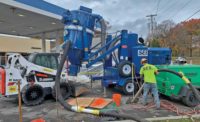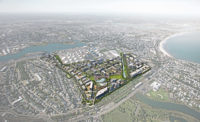As the calendar flipped to 2021, people across the construction industry and the world hope for a new start. But it’s a worthwhile effort to look back for a moment at 2020’s largest construction starts in Connecticut, Maine, Massachusetts, New Hampshire, Rhode Island and Vermont.
Compiled from information supplied by Dodge Data & Analytics and other sources, the 20 projects listed on this year’s ranking began substantial construction during 2020. The combined value of this year’s Top Starts is $5.9 billion, the same total reached for the 20 largest projects on last year’s list.
The top-ranked project, South Station Tower in Boston, at $870 million, is valued at about the same level as last year’s top project, the Winthrop Center, also in that city. The minimum project value on this year’s list is $125 million, however, down from last year’s minimum of $189 million.
Boston-based Suffolk is listed as the construction manager or general contractor on the South Station Tower as well as on five other projects: Parcel 12 Office Tower and CitizenM Hotel (ranked No. 2 at $700 million); Boston University Center for Computer and Data Sciences (ranked No. 7 at $288 million); Seaport Square (ranked No. 10 at $250 million); Northeastern University EXP (ranked No. 12 at $225 million); and Landmark Center Lab/R&D/Office Building (ranked No. 15 at $160 million).
Two listed schools are being built by Consigli Construction: Waltham High School (ranked No. 5 at $374 million) and Arlington High School (ranked No. 6 at $290 million). The Milford, Mass., firm is also construction manager for the Dartmouth Hitchcock Medical Center Patient Pavilion (ranked No. 17 at $150 million) and the University of Connecticut STEM Research Center and Utility Tunnel (ranked No. 19 at $140 million). Executives from two other firms with projects on this year’s list, Dellbrook | JKS and HNTB, shared regional market insights with ENR. Their responses have been edited for space and clarity.
|
Related Link |
How has COVID-19 affected your firm?
Mike Fish, president & CEO, Dellbrook | JKS: It has forced us to really look deep at what are the pros and cons of both the old office workplace and the new remote workplace, and how can we create a hybrid that gets the best of both. Ultimately, a lot of good can come from great obstacles, and we are really excited to take these lessons learned and improve moving forward.
Gary Bua, Massachusetts office leader and senior vice president, HNTB: Because transportation agencies and the contractors/vendors that support them were deemed essential business, we have been fortunate to be able to continue to advance most of our design projects.
What are major construction trends in the New England region?
Fish: The outer urban and suburban multifamily housing is still on fire with no sign of slowing down. Our affordable housing backlog is always strong, which is helping mitigate the reduced amount of spending in the health care sector. We have also seen some select private/Catholic educational opportunities open up as they have seen enrollment skyrocket with a lot of families switching from public to private schooling opportunities. The office and retail sectors have been hit hard throughout the pandemic, but the life sciences as well as distribution/industrial sectors have remained strong as well.
Bua: For the most part, our projects have largely continued to move forward and stay on schedule. Transportation agencies have done a good job adapting to a remote work environment and have continued to procure, deliver and advance critical transportation infrastructure projects. Additionally, many of our clients have taken the opportunity to complete these projects on an accelerated schedule.
What key innovations helped your firm boost productivity or other metrics?
Fish: Our use of QR codes at jobsites has been helpful to allow worker check-in on our sites to be as efficient as possible. Doing weekly internal video updates allowed our leadership to connect with employees and try to make up for the lack of physical connection.
Bua: HNTB’s Public Involvement Management Application has provided a platform to our clients and projects to allow for virtual public involvement. Being able to communicate effectively with the public and capture their comments and concerns on our projects in a remote environment has been incredibly effective.
Where do you see the industry in the region headed in the next year in terms of trends, innovations, etc.?
Fish: A hybrid model of work from the office/work remotely is here to stay to allow for maximum efficiency and work life balance. Also, the use of QR Codes will continue to evolve from a data and tracking of manpower standpoint. Finally, I think that jobsite safety was forced to innovate in numerous different ways throughout the pandemic to allow sites to continue operating safely, which our team will continue to grow upon.
Paul Godfrey, Northern New England office leader and vice president, HNTB: All indications point to the new federal administration providing strong support to transportation infrastructure. We are hopeful that [the] stimulus bill and reauthorization of a federal surface transportation bill will be key in helping the U.S. economy rebound. Projects that promote reduction of greenhouse emissions and resilience from climate change will gain more attention. An influx of funding from the federal government for transportation will allow for critical projects to advance and potentially accelerate.






